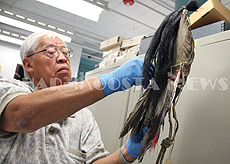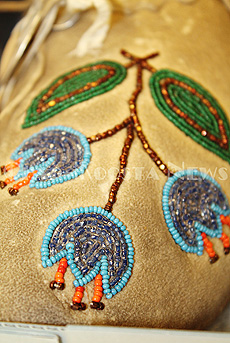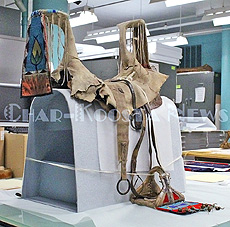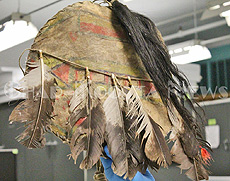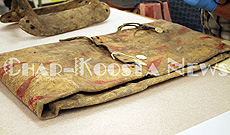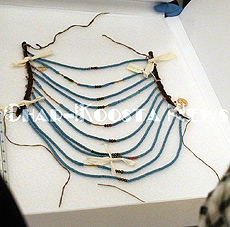 |
Canku Ota
|
 |
|
(Many Paths)
|
||
|
An Online Newsletter
Celebrating Native America
|
||
|
September 2015 - Volume
13 Number 9
|
||
|
|
||
|
Tribal Artifacts
To Return To CSKT
|
||
|
by Naomi Robinson -
Char-Koosta News
|
||
|
University of Montana returns artifacts to Confederated Salish and Kootenai Tribes in an unprecedented way: without red-tape and no strings attached
Missoula, MT — It's not often artifacts are returned to a tribe without red-tape and never-ending legal processes, but that changed recently at the University of Montana. Cultural artifacts with origins to the CS&K Tribes held at the UM's repository for over 60 years are in the process of being returned.
In April, CSKT tribal staff, U of M, and delegations from other tribal nations discussed the potential for the repatriation of property and cultural artifacts held in the University trust. A partnership of this kind is highly unique due to the fact that the University is repatriating the artifacts without going through the bureaucratic "red-tape" often associated with this type of property. Collected over decades, over 800 artifacts make up the U of M collection. The Salish Pend d'Oreille Culture Committee (SPCC), along with Tribal Preservation and the People's Center, identified 82 artifacts as Salish or Pend d'Oreille. An additional 100 plus artifacts still need to be inspected and identified.
Leaving all personal belongings close to the front door, staff entered the restricted access repository and donned surgical gloves. Armed with paper, pens and cameras, the time consuming examinations began. Carefully handling each artifact, each article must be examined, identified, photographed, and a detailed description is written. Any damage and notations of usage must also accompany each piece.
Received in 1951 from a private collector, a women's saddle was the first article of business. Covered in white buckskin, the artistic beadwork that adorned both front and back saddle horns and stirrups was accredited to Catherine Lassaw. Modified at some point, the traditional saddle has a more western style as the underlying base. Hidden under the front saddle horn, the reign holder was fully intact. Beaded and decorated stirrups with hawk bells showed the saddle was in remarkably good shape. Tony Incashola, SPCC director admired the work as staff examined it. Incashola, said "Work like this, pieces that are highly adorned, weren't usually every day use pieces. This was more likely a show piece, for special occasions. " SPCC Collections Manager Sadie Peone noted that today most beadwork artists place backing on their artwork; this piece did not have such backing. "This is pretty neat," Peone said, "you can really see how they did their stitching and how well it has held."
Other items included a child's cloth legging set. Decorated with beadwork on the bottom, despite a few visible damage spots the leggings were also in good shape. Acknowledging the work that went into the creation of these items, Incashola said, "A lot of love went into these items. It takes patience and work to bead. These items are very special."
In protective wrapping, one item awaited its turn to be examined. Original paperwork that accompanied the package stated, "Scalp war shield." All staff gathered around its unveiling. As the shield became more visible, gasps of admiration could be heard. According to the documentation the shield came into the collection by a private donor, Paul Pichette. Donated in 1950, the rawhide shield was highly decorated with seven eagle feathers, hand-painted designs in green, red and yellow paints, and a handful of black hair. Originally noted as a scalp war shield, Incashola noted that this was a great example of why each artifact must be examined. The "scalp," as it turned out, is a horse tail, not an actual human scalp. The correction was noted on the written detail sheet. Carefully placed back into its wrapping the shield will eventually be moved into a more permanent resting place.
Many of the items that the tribes have identified will have to wait to be housed back on the reservation. Currently the tribes do not have a repository large enough to meet the needs of this collection. To preserve collections like this, it takes a building that can accommodate the special needs many of these items needs. Moisture, air temperature, and even light, can damage items over time.
The University of Montana has agreed that until the CSKT and many other tribal nations can accommodate their part of the collection in whole or in part, that they will continue to house the artifacts. According to U of M Professor Dr. C. Riley Auge, "There are no timelines or restrictions for any of the Tribes to reclaim their artifacts. The University of Montana wants to return these artifacts back to where they belong, and that is with their people. It's just the right thing to do." |
||||||||||||||||
|
|
|
|
||
|
|
||
| Canku Ota is a free Newsletter celebrating Native America, its traditions and accomplishments . We do not provide subscriber or visitor names to anyone. Some articles presented in Canku Ota may contain copyright material. We have received appropriate permissions for republishing any articles. Material appearing here is distributed without profit or monetary gain to those who have expressed an interest. This is in accordance with Title 17 U.S.C. Section 107. | ||
|
Canku Ota is a copyright ©
2000 - 2015 of Vicki Williams Barry and Paul Barry.
|
||
 |
 |
|
|
The "Canku
Ota - A Newsletter Celebrating Native America" web site and
its design is the
|
||
|
Copyright ©
1999 - 2015 of Paul C. Barry.
|
||
|
All Rights Reserved.
|
||
